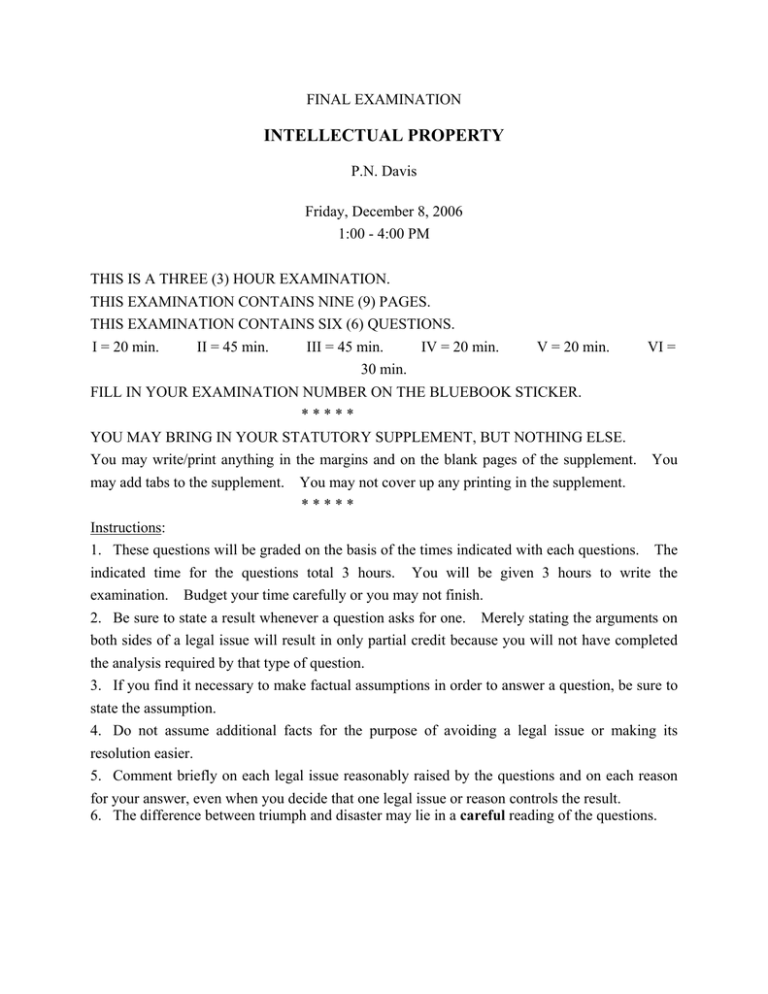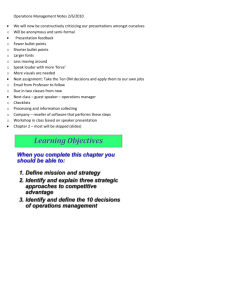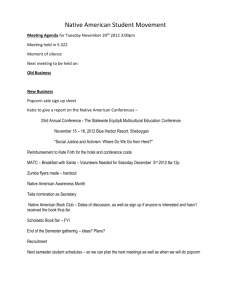INTELLECTUAL PROPERTY
advertisement

FINAL EXAMINATION INTELLECTUAL PROPERTY P.N. Davis Friday, December 8, 2006 1:00 - 4:00 PM THIS IS A THREE (3) HOUR EXAMINATION. THIS EXAMINATION CONTAINS NINE (9) PAGES. THIS EXAMINATION CONTAINS SIX (6) QUESTIONS. I = 20 min. II = 45 min. III = 45 min. IV = 20 min. V = 20 min. VI = 30 min. FILL IN YOUR EXAMINATION NUMBER ON THE BLUEBOOK STICKER. ***** YOU MAY BRING IN YOUR STATUTORY SUPPLEMENT, BUT NOTHING ELSE. You may write/print anything in the margins and on the blank pages of the supplement. You may add tabs to the supplement. You may not cover up any printing in the supplement. ***** Instructions: 1. These questions will be graded on the basis of the times indicated with each questions. The indicated time for the questions total 3 hours. You will be given 3 hours to write the examination. Budget your time carefully or you may not finish. 2. Be sure to state a result whenever a question asks for one. Merely stating the arguments on both sides of a legal issue will result in only partial credit because you will not have completed the analysis required by that type of question. 3. If you find it necessary to make factual assumptions in order to answer a question, be sure to state the assumption. 4. Do not assume additional facts for the purpose of avoiding a legal issue or making its resolution easier. 5. Comment briefly on each legal issue reasonably raised by the questions and on each reason for your answer, even when you decide that one legal issue or reason controls the result. 6. The difference between triumph and disaster may lie in a careful reading of the questions. I. (20 minutes) Horizontal (or lateral) directional drilling is used to avoid the necessity of digging a lateral trench for the installation of underground pipes and utility lines. It is used, for example, to install utilities around immovable objects such as roads, railroads, rivers, or lakes. Because the ground near the surface is composed of a variety of soft and hard materials, often mixed together, special drill bits are needed to cope with those varying conditions. William Cody overcame problems with prior art drill bits when boring through hard rock formations. His patent application disclosed a drill bit with a body that contains fixed and semi-floating cutting points and one or more fluid channels to lubricate and disperse formation chips that have been cut or fractured, without using jetting fluids that traditionally are used to steer horizontal drilling apparatus. Cody applied for patents for the drill bit and the drilling method in November 1997. The PTO issued a patents for this drill bit [the ‘283 patent] and for the method for horizontal directional drilling with that drill bit [the ‘743 patent] to Cody on June 4, 2000, On July 10, 2001, Cody sued Underground Tool Company for infringement of his patents, based on its manufacture and distribution of a competing drill bit. In its defense, Underground Tool presented the following evidence. First, according to Cody’s own testimony, he had allowed Earl Forman, an employee of Jones Constructors, on six occasions beginning in January 1996 to test the drill bits on jobs contracted to Jones Constructors. The first test was along the edge of the public right-of-way of an interstate highway. Forman drilled an average of 400 feet per day for a three-week period. Cody did not supervise or observe the actual use of the drill bit and drilling method by Forman. However, the drilling by Forman was observed by the highway department’s supervising highway construction engineer. After each test, Cody modified his drill bit in minor ways, but none of the changes affected its basic design. The purpose of the tests was to determine whether Cody’s drill bit and drilling method functioned properly. These six tests also were to establish the durability of the drill bits. These tests, using several examples of the same drill bit design, were conducted over a period of 8 months and all were successful. Second, Cody began offering his drill bit for sale in October 1996, although no sales were made until February 1997. There is no question that Underground Tool’s competing drill bit and drilling method incorporated all the features claimed by Cody in his patents. Should the district court hold that Cody’s patents were in fringed or that they were invalid? Discuss all relevant legal issues. State a result. 1 2 II. (45 minutes) Richard Foley is a self-taught photographer who produces photographs with social and political overtones. In 2002, he shot a series of 50 photographs entitled “Food Chain Barbie,” which depicts the Barbie doll in various absurd and sometimes sexual positions. Foley uses the word “Barbie” in some of the titles of his photos. Generally, he places one or more nude Barbie dolls with vintage kitchen appliances. For example, “Malted Barbie” features a nude Barbie on a vintage Hamilton Beach malt machine. “Fondue Barbie” depicts Barbie heads in a fondue pot floating in chocolate fondue. “Barbie Enchiladas” shows four Barbie dolls wrapped in tortillas and covered with salsa in a casserole dish. Foley displayed his photos at two art festivals in Park City UT and Kansas City MO. He promoted his photos with a sample postcard, a business card, and a website. In his promotional literature, Foley states that his photographs critique the “objectification of the conventional beauty myth and societal acceptance of women as objects, because this is what Barbie embodies.” In 3 years, Foley sold the photos as postcards, cumulatively selling 500 of the 2000 printed. These sales yielded $3,000. Mattel owns the Barbie doll franchise and has made millions over the past 45 years. At the time it began selling Barbie dolls in 1961, it registered the word Barbie as a trademark for the familiar doll and it filed a copyright registration for the doll’s image. Mattel sued Foley in 2005. Does Mattel have valid cause(s) of action? Does Foley have valid defense(s)? Identify them. Explain the rationales for each. Discuss all relevant legal issues. State a result as to each cause of action and defense.. 3 III. (45 minutes) George Green does business as “Ye Olde Popcorn Shoppe.” in St. Louis. He opened his shop in 1998 adjacent to a beauty salon run by his sister, Initially, Green sold three types of popcorn – butter, caramel, and cheese – to salon customers. Soon, he was selling popcorn at other beauty salons. His original packaging was cellophane with a small yellow label with red lettering describing its contents and prominently displaying the brand Ye Olde Popcorn Shoppe.. In 2000, Green decided to pursue wholesale marketing of his product. As part of this effort, a designer created new packaging for Green’s Chicago Style mix of his three types of popcorn. The main elements of this packaging was (1) the brand name Ye Olde Popcorn Shoppe in red letters on the top of the bag, (2) a description of the contents Chicago Style Mix in red letters also on the upper portion of the bag, (3) a depiction of the Chicago IL skyline in red on a yellow background in the middle of the bag, and (4) red and yellow colors on the top and bottom of the bag. (Note: “Chicago Style” refers to a mixture of caramel, butter, and cheese popcorn and is a common label in the popcorn industry, derived from the Chicago street vendors that originated the mix in the mid-1980's.) With the new package, Green approached Major Brands, a midwestern retailer which operates 125 stores. He met with Major’s salty snack buyer in early 2001. Major’s buyer tasted Green’s product and looked at his packaging. Major agreed to make shelf space available in all its stores beginning in July 2001. Major had begun to develop its own private-label “Chicago Style” popcorn in 1997 and began selling the product in a few stores in Michigan as a marketing test. A year later, it expanded its sales of private-label popcorn to all of its stores. Major’s original popcorn package had a yellow-checkered background with red and blue lettering, no trim, and no depiction of the Chicago skyline, but did include the description Chicago Style. In early 2001, Major commissioned a redesign of its entire private-label salty snack food line, including its popcorn. It hired a free-lance graphic designer. She completed her redesign in summer 2001 and her design changes were incorporated into the popcorn bag beginning in late 1996. Later, she attested that she did not know of or refer to Green’s popcorn package design when she redesigned Major’s packaging. Major’s designer’s redesigned packaging used similar colors to those on Green’s packaging and both included the description Chicago Style. While both had a silhouette of the Chicago skyline, they are viewed from different perspectives. Major’s skyline is in black at the bottom of its bag, while Green’s is in red in the middle of its bag. Major’s bag has a big popcorn kernel on the front and the brand Major is in red prominently located at the top of its bag. Green’s Ye Olde Popcorn Shoppe also is prominently displayed in red at the top of the bag, 4 but is in a distinctly different font. Major shelves products by source, not by product type. All of its private-label snack foods were shelved together, including its “Chicago Style” popcorn. Beginning in July 2001, Major shelved Green’s popcorn either on the aisle “endscape” or in center aisle displays, the premium spots designed to feature new products; this was standard practice. Neither location was anywhere near the private-label shelving in any of Major’s stores. Because of low sales, Major discontinued carrying Green’s popcorn in April 2002. Green had sold only a total of 1200 cases of his popcorn (200 cases to Major) and had done very little advertising or other promotions of his product. Green’s business went bankrupt the following year because of inadequate sales elsewhere. In 2004, Green decided to sue Major, alleging the Major copied its popcorn bag. What causes of action would be appropriate for his suit? Does Major have any viable defenses? Discuss all relevant legal issues. State a result. 5 IV. (20 minutes) Thomas is assignee of the Tubis ‘717 patent which claims a cost-effective method of producing, in low volume, multicolor faces for watches, clocks, thermometers, and other instruments. The method includes making a graphic instrument face in a computer, transmitting electronic signals from the computer to a color printer or photocopier, printing the face on sheet material, cutting it, and assembling it into an instrument. Tubis, the patentee, filed his application in June 1993 and obtained his patent in July 1997. Claim 3 of the ‘717 patent recites: 3. A method of constructing a functional multicolor element having indicia thereon, utilizing a computer and a color photocopier, comprising the steps of: (a) electronically creating or providing in the computer an electronic simulation of the desired functional multicolor element, with indicia thereon; (b) under the control of the computer, transmitting electronic signals from the computer to the photocopier so that the photocopier transforms the electronic simulation of the desired function multicolor element onto a piece of sheet material. Watches-USA Corporation produces watches and clocks with customized faces, and has done so for over 18 years. Initially, Watches-USA created and printed its customized graphics using pad printing, engraving, silk screening, or photography, all of which were expensive and required extensive set-up time. Thus, those older methods were not suited to small-volume custom design and printing. In the late 1980's, desktop publishing technology mitigated the design side of these processes, but high-resolution color printing remained very expensive. High-resolution color laser printing technology was developed in the early 1990's. Watches-USA began using that technology to make custom watches and clocks in 1995. Thus, it has combined computer graphics design technology and computer-controlled color laser printing technology. Swiss Watch LLC also is in the customized watch business. In a 1991-92 catalogue, published in September 1991, it advertised the availability at an inexpensive price of small-volume multi-color watches produced by “a new computer laser printer.” Its catalogue stated that the customer must submit “camera ready, color separated artwork,” that is, separate pieces of black and white artwork representing each color in the customer’s design. Swiss Watch did not offer to produce the graphics needed to create that artwork. Neither Tubis nor the patent examiner were aware of this catalogue during the examination of the ‘717 patent 6 application. In November 1999, Thomas brought suit against Watches-USA for patent infringement. Assume the patent examiner was correct that the ‘717 recited novel technology. Assume also that Watches-USA does not use a computer-controlled color laser photocopier, but does use a computer-controlled color printer, in its process. (The difference is that a color photocopier is driven either by a scanned image or externally by a computer, while a color printer must be driven by an external computer. It does not matter whether either uses color laser xerographic technology, dot matrix technology, or whatever.) Should the district court find or not find infringement? What defenses, if any, does Watches-USA have? Discuss all relevant legal issues. State a result. 7 V. (20 minutes) Sam Ranks and Joseph Sheldon created the cartoon character “Psycho Chihuahua” which they promote, market, and license. The character is a clever, feisty dog of the Chihuahua breed with an attitude: a self-confident, edgy cool dog who knows what he wants and will not back down. In August 2002, Ranks and Sheldon attended a licensing trade show in new York City where they were approached by two senior officers of the Taco Taco franchise. They expressed interest in the “Psycho Chihuahua” character which they thought would appeal to its core customers. After internal discussions back at headquarters, Taco Taco invited Ranks and Sheldon to prepare art boards showing “Psycho Chihuahua” combined with the Taco Taco brand name and logos. This Ranks and Sheldon did. With the art boards, Ranks and Sheldon included a draft licensing agreement. The art boards and draft licensing agreement were circulated among several top executives at Taco Taco. Instead of using the “Psycho Chihuahua” cartoon character, Taco Taco executives decided to use photographic images of a live Chihuahua dog manipulated by computer graphics imaging in its TV advertising. It would combine the personality of “Psycho Chihuahua” and a love of Taco Taco Mexican-style food. Taco Taco returned the art boards to Ranks and Sheldon with a letter declining to use their cartoon character or to enter into a licensing agreement. In September 2003, Taco Taco aired its first Chihuahua TV advertisement and received a very positive public response. The Chihuahua then became the focus of its 2003-04 marketing campaign. Ranks and Sheldon sued Taco Taco in February 2004. What cause(s) of action should they use? Does Taco Taco have any valid defenses? Discuss all relevant legal issues. State a result. 8 VI. (30 minutes) Briefly define the following terms: (1) trade secret (2) anticipation (3) palming off (4) concreteness (5) public performance (6) contributory infringement (7) utility (8) conception (9) right of publicity (10) right of integrity 9 INTELLECTUAL PROPERTY – Fall 2006 P.N. Davis I. (20 min.) public use: § 102(b) - public use and on sale bar– patent is barred either public use is begun more than one year before application. use by third party was permissive. use was in a public location (highway row). use was observed by member of public (highway engineer). thus, the tests were “public uses. experimental use defense: limited experimental use in public may be done to test operativeness of invention. such use is limited to the amount necessary to determine operativeness. since all tests were “successful,” only the first can be considered experimental, proving operativeness; thereafter, all remaining tests were “public uses.” the one-year period under § 102(b) expired before Cody applied for a patent. “on sale” bar § 102(b) bars patent if invention was offered for sale more than 1 year before application. offer need not be accepted immediately, or at all; period between actual sale and application is irrelevant.. RESULT: patents are invalid; D is not liable for infringement. II. (45 min.) copyright infringement rights in serialized characters derivative work trademark infringement purposes of TM: avoid consumer confusion protect TM owners from false impression of product association/endorsement trademark dilution will blur the uniqueness and singularity of TM, or will tarnish it limited to commercial speech parody of TM is not actionable under 1st Amendment 1 fair use - copyright & trademark parody amount of use can be no more than reasonably necessary to conjure up the original must be “transformative” 4 factors: purpose & character of use D didn’t use Barbie to identify his own products; his use does not imply endorsement of D’s products; rather Barbie was subject matter vehicle for D’s parody nature of copyrighted work amount & substantiality of portion used effect of use on potential market none of Barbie’s traditional markets are impaired likelihood of confusion test - trademark infringement & dilution bonus: product identification entering public discourse Rogers balancing test [Rogers not discussed as such in class – 1st Amendment issue is matter of 1st impression on exam] III. (45 min.) trade dress infringement: Lanham Act § 43(a) protects trade dress. Elements: (1) if has acquired secondary meaning. def. secondary meaning: (2) trade dress of two competing products are likely to cause consumer confusion. (3) appropriated features of the trade dress are primarily nonfunctional. common law unfair competition: elements: (1) appropriation of business good will by false or misleading labeling. (2) by a competitor. (3) with consequence deception among consumers. This can occur only if there is a likelihood of consumer confusion. likelihood of confusion. Factors: (1) strength of plaintiff’s mark. distinctiveness of the two marks: colors: primary colors and common graphic elements are not distinctive. Chicago skyline silhouette is not unique. Chicago Style: is commonly used in popcorn industry to designate 2 (2) (3) (4) (5) (6) (7) (8) popcorn mix of three types of popcorn. Green’s sales too small for public to have associated his packaging with his product. Green had done little to promote his brand. relatedness of goods. both competitors are selling the same product. similarity of the marks. test is whether the average consumer would find the two marks confusingly similar. the general impression of the average consumer about the two marks is relevant, not a point-by-point side-by side comparison. evidence of actual confusion. since no marketing survey s were conducted, there is no evidence about actual confusion. marketing channels used. both products were sold in the same stores. but in different locations in those stores – so the consumer would not be able to make side-by-side comparisons. Major’s salty snack products were all located together – thus, consumer is unlikely to think Major’s popcorn was someone else’s. this reduces the likelihood of consumer confusion. likely degree of purchaser care. average customer is not likely to exercise great care, or do comparitive evaluation, of relatively inexpensive products. defendant’s intent in selecting the mark. Major’s bag was designed by a person not involved in selecting brand name salty snack products. she alleges that she knew nothing about Green’s bag, and there is no evidence to the contrary. intent is an issue only when there is confusing similarity. bonus: copying public domain elements is permitted. likelihood of expansion of the product line. not an issue in the case. RESULT: Green’s trade dress is weak, because there is considerable dissimilarity and public domain elements were used. There is little evidence of likelihood of confusion. Therefore, Green’s trade dress is not protectable. IV. (20 min.) Novelty: § 101(a). an invention is anticipated it contains each and every element of a single prior art reference. novelty is assumed in this question. Obviousness: § 103. 3 a patent cannot be granted if the invention was obvious at the time of invention. an invention is obvious if elements from two or more prior art references could be combined by a person having ordinary skill in the technology which is the subject matter of the invention. each element must antedate the invention. here, the computer-aided graphics design technology used by Watches-USA and the computer-controlled color printing technology used by Swiss Watch each antedated the ‘717 invention. - the Swiss Watch catalogue was published before the Tubis ‘717 application. - substitution of an externally-controlled color printer for a color printer incorporated into a color photocopier also is obvious. Infringement – defenses: infringer may raise as a defense improper granting of plaintiff’s patent. thus, obviousness may be raised as a defense. RESULT: ‘717 patent was obvious at the time of invention – patent is invalid. V. bonus: (20 min.) misappropriation of ideas: elements: (1) taking of work product of another (2) without consent (3) for commercial advantage. idea must be: (1) novel or original, (2) distinctive or concrete. here, “Psycho Chihuahua” cartoon character idea was original and distinctive. preemption: but Copyright Act preempts this cause of action, because it provides a form of protection equivalent to that provided by the Act. § 301. copyright infringement: creative idea must be reduced to a tangible medium of expression. § 102(a). creative idea must be original with creator, but need not be novel. creative work can be published or unpublished. § 104. “Psycho Chihuahua” idea was reduced to cartoon drawings (at licensing trade show, and art boards submitted to Taco Taco). drawings are inherently original, even if containing public domain or generic ideas. drawings are protectable by copyright. § 102. since 1989, Copyright Act has not required placement of copyright notice on the work. § 405(a). protection of cartoon characters extends to their appearance in other works and includes their personalities. [Air Pirates] thus, recasting the cartoon character with computed-manipulated graphics of a live Chihuahua is creation of a derivative work. 4 preparation of derivative works is an exclusive right of copyright owner. § 106(2). facts imply that Taco Taco used the “Psycho Chihuahua” concept as a basis for its computer-manipulated graphics based on a live dog. This is an issue of fact. RESULT: Taco Taco is liable for copyright infringement. (Result is similar to Puff ‘n’ Stuff”.) VI. (30 min.) Briefly define the following terms: (1) trade secret (2) anticipation (3) palming off (4) concreteness (5) public performance (6) contributory infringement (7) utility (8) conception (9) right of publicity (10) right of integrity 5



